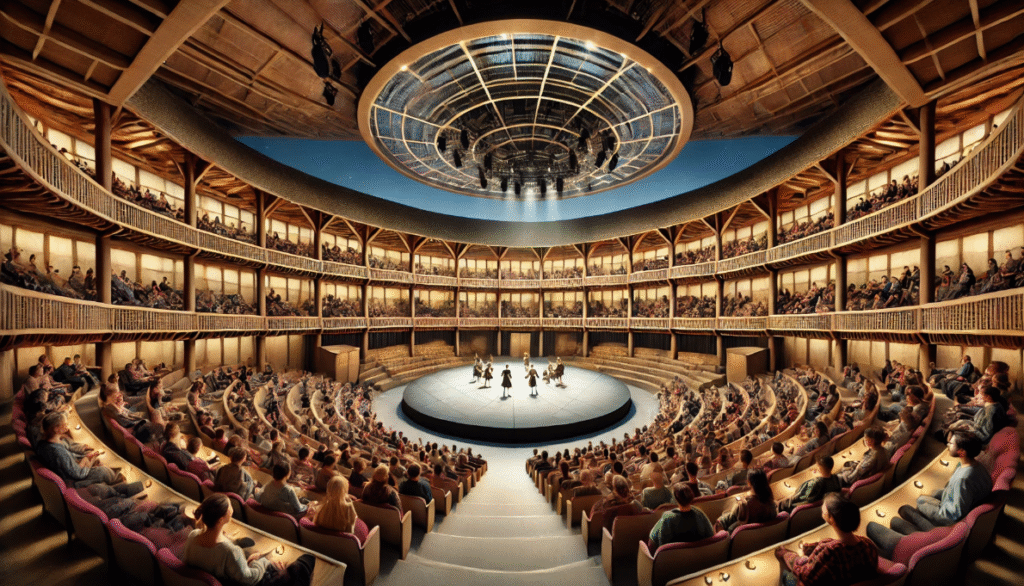
Shakespeare’s Impact on Theatre Design: How His Innovations Shaped Modern Stage Architecture
Did you know that the stage you’re sitting in today—whether for a Broadway show, a local production, or a modern musical—owes much of its design to one man: William Shakespeare? 🎭 While Shakespeare is best known for his literary genius, his impact on theatre design is often overlooked. However, the innovations he introduced have shaped the very way we experience live theatre today.
In this article, we’ll explore Shakespeare’s impact on theatre design and how his groundbreaking ideas revolutionized the way stages are built and how audiences interact with performances. Whether you’re a theatre lover, aspiring designer, or just curious about the history behind the curtain, you’ll discover how these age-old innovations are still influencing modern architecture and stage design. Ready to dive in? Let’s uncover the secrets behind Shakespeare’s lasting legacy!
Table of Contents
Toggle1. The Origins of Theatre Design: Before Shakespeare
Before Shakespeare’s groundbreaking innovations, theatre design was relatively simple and utilitarian. Performances took place in open-air spaces or indoor venues with limited set designs and little thought given to stage architecture. Let’s explore what theatres looked like before the Bard’s influence transformed them. 🎭
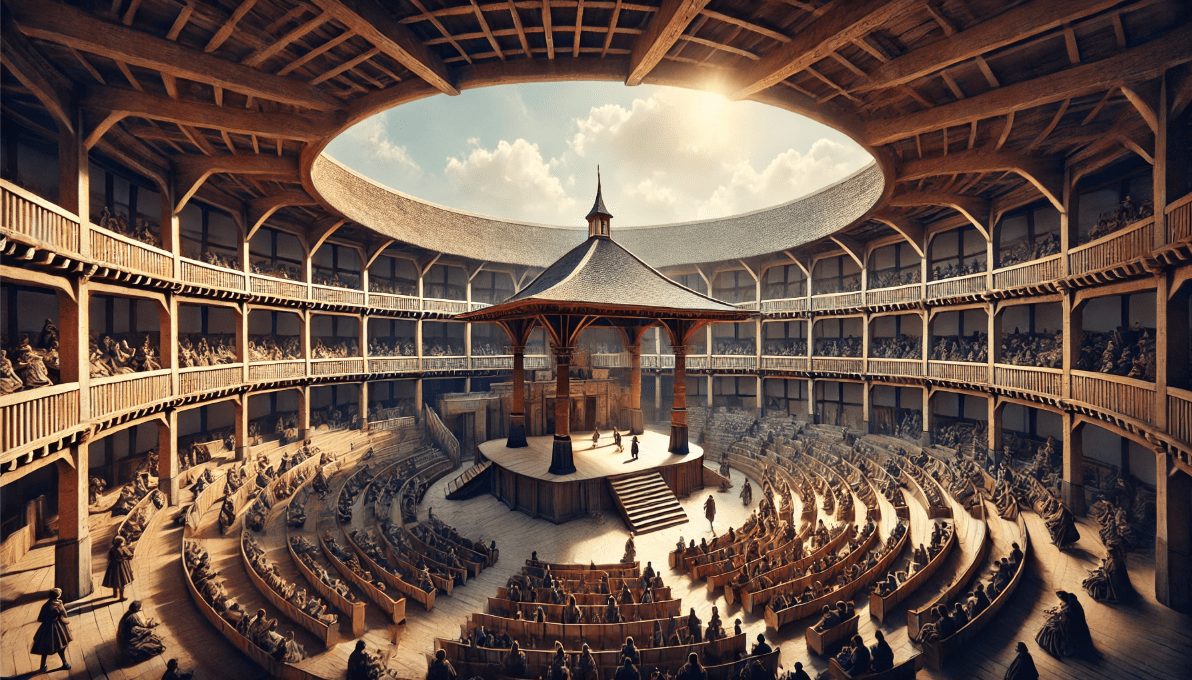
Outdoor and Open-Air Venues
In ancient Greece and Rome, theatres were large, open-air structures designed to fit thousands of spectators. These early stages were often built into hillsides, with the audience seated in a semicircle around the stage. The focus was on natural acoustics rather than intricate stage design, and actors performed on large, flat platforms, typically with minimal props.
Medieval Indoor Stages
During the medieval period, performances often took place indoors, in guild halls or makeshift spaces, such as the courtyards of castles. The stages were small, and the focus was more on the actors’ performances than on any elaborate scenery. Backdrops or props were often basic, and the interaction between the actors and the audience was minimal. The “fourth wall” — the imaginary barrier between actors and the audience — was already starting to form.
Challenges with Early Designs
- Limited Engagement: The stages were often static, with actors placed far from the audience.
- Minimal Scenic Design: Most sets were rudimentary, offering little in terms of atmosphere or setting.
- Lack of Visual Appeal: The simple setups meant that productions were heavily reliant on dialogue and minimal stagecraft.
These limitations created a need for more dynamic and engaging theatre spaces. Shakespeare saw this opportunity and changed the game by introducing innovative designs and stage elements that would evolve the theatre experience for centuries to come. 🌟
2. The Globe Theatre and Its Revolutionary Design
The Globe Theatre is one of the most iconic symbols of Shakespeare’s lasting influence on theatre design. Built in 1599, it wasn’t just a place for actors to perform—it was a groundbreaking step in how theatre spaces were structured, leading to innovations still visible in modern theatres today. Let’s dive into the features of the Globe that made it revolutionary. 🎭
The Circular Shape: Immersing the Audience
One of the Globe Theatre’s most innovative features was its circular design, which set it apart from traditional rectangular stages. The open, circular space allowed actors to be surrounded by the audience on all sides, creating a more immersive and dynamic performance. Unlike earlier theatres, where the action was mostly one-directional, the Globe embraced a more intimate setting, fostering a stronger connection between actors and the audience. 👥
- Practical Insight: Modern theatres often use circular or semi-circular stage designs (called thrust stages) to encourage greater interaction and closer engagement with the audience.
The Thrust Stage: Breaking the Fourth Wall
The Globe used a thrust stage, where the performance space extended into the audience, allowing actors to move among the crowd. This design broke the traditional “fourth wall” by removing the physical barrier between performers and spectators. This close proximity made the experience more intimate and heightened emotional involvement in the play. 🌟
- Practical Tip: If you’re designing a performance space, consider a thrust stage for a more engaging and interactive atmosphere. This layout has become a standard in many contemporary theatres for its immersive qualities.
Three-Tiered Structure: Maximizing Space
The Globe Theatre was built with three tiers of seating, which accommodated a range of audiences. The “groundlings” stood in the yard (the open space in front of the stage), while wealthier patrons sat in the more comfortable upper tiers. This division made theatre accessible to a wider social class and allowed the theatre to hold a large audience. 🎫
- Actionable Insight: Many modern theatres have adopted this multi-level seating arrangement to cater to diverse audiences and create a dynamic experience. The tiered structure helps ensure that everyone has a good view of the performance.
Minimalist Scenic Design: Focus on Performance
Unlike modern theatres with elaborate sets, the Globe had minimalist scenic designs, relying on the actor’s words and physical movements to set the scene. Shakespeare’s plays used simple props and the audience’s imagination to create vivid settings. This approach allowed for quick changes and greater focus on the actors’ performances. 🎭
- Practical Tip: Consider focusing on minimalist designs that highlight storytelling. This can create a more engaging experience without overwhelming the audience with too many distractions.
Natural Lighting and Acoustics: Maximizing the Environment
The Globe was open to the sky, using natural lighting during performances. This not only added to the realism of daytime scenes but also kept costs low. The shape and structure of the theatre also helped with acoustics, ensuring that actors’ voices carried to every corner of the space, even without microphones. 🌞
- Actionable Insight: In modern theatres, designers continue to prioritize lighting and acoustics to enhance the audience’s experience. Consider how natural light or well-placed artificial lighting can influence the atmosphere of your performance space.
The Globe Theatre was not just a physical space—it was a revolution in how theatre was experienced. Shakespeare’s innovative use of stage design, audience engagement, and space utilization has shaped the very way we experience theatre today. From thrust stages to tiered seating, the Globe’s legacy continues to inspire theatre designers around the world. 🎭
3. Stage Layout Innovations: Shakespeare’s Influence on Modern Design
Shakespeare didn’t just revolutionize the content of theatre; he fundamentally changed how it was presented. His impact on stage layout continues to influence modern theatre design, especially with features like the thrust stage and flexible performance spaces. Let’s explore how Shakespeare’s innovative stage layouts paved the way for today’s theatre designs. 🎭
The Thrust Stage: Creating Proximity and Immersion
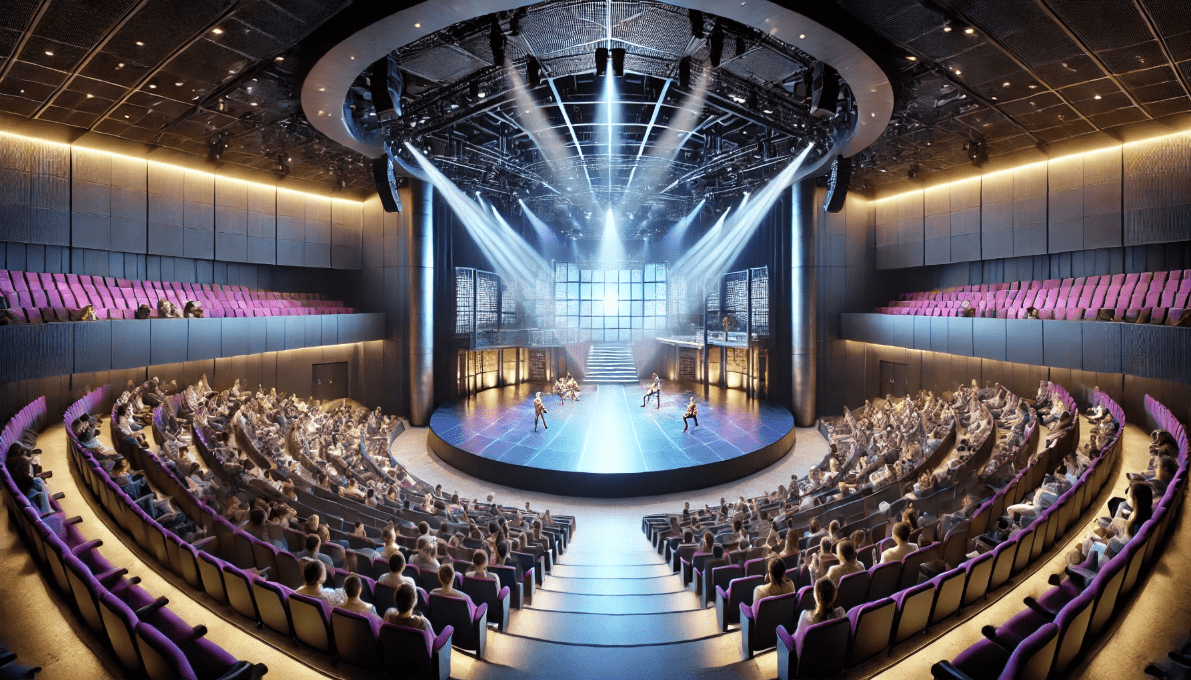
The most significant contribution of the Globe Theatre’s design was the thrust stage, where the acting area extended into the audience. This allowed the actors to be surrounded on three sides by the audience, making the experience more immersive and engaging.
- Practical Insight: Modern theatres that use thrust stages (like many of today’s Shakespearean plays) create a more personal and dynamic connection between the performers and the audience. This setup is still popular in contemporary theatres for its ability to engage the audience on a deeper level. 💡
Arena-Style Seating: Breaking Down Barriers
Shakespeare’s Globe helped set the foundation for arena-style seating, where the audience surrounds the stage on all sides. This design fosters a feeling of being part of the performance rather than just observing it. The proximity between the performers and the audience breaks down the traditional “fourth wall,” making the experience more interactive.
- Actionable Insight: If you want to create a more interactive and immersive performance, consider adopting arena-style seating in your theatre designs. It’s a great way to encourage audience participation and create a lively atmosphere. 😊
Multi-Level Staging: Dynamic Performances
The Globe Theatre was designed with multi-level staging, where actors could move between different levels of the stage, enhancing the visual interest of the performance. This flexibility allowed for quick scene changes and created a more dynamic staging environment. The multi-level structure not only kept the audience engaged but also allowed for different perspectives, adding depth to the narrative.
- Practical Tip: Modern theatres often use revolving stages or multi-level sets to provide visual variety and create more dynamic performances. These features can be especially effective in complex plays or productions with multiple settings.
Flexible Spaces: Encouraging Creativity
Shakespeare’s theatre didn’t just rely on elaborate scenery—it embraced flexibility. The simple, adaptable stage design meant that productions could quickly shift between scenes and locations. The use of minimal props and sets allowed the focus to remain on the actors and the story, without overwhelming the audience with too much detail.
- Actionable Insight: If you’re a designer, remember that flexibility is key. A flexible stage can transform from one scene to another with minimal effort, making it easier to tell a complex story. Minimalist sets that prioritize storytelling over heavy props are often more effective and engaging. 🎬
Audience Engagement: Bringing Viewers Into the Action
Shakespeare understood the importance of audience engagement. In the Globe, the audience wasn’t just passive; they were part of the action. Whether standing in the pit or sitting in the galleries, the design kept the audience close to the performance, making them an integral part of the experience.
- Practical Insight: Theatre designers today continue to value audience proximity. Whether through open seating or stage positioning, bringing the audience into the experience helps build emotional connections and makes the performance feel more alive.
Shakespeare’s stage layout innovations were ahead of their time and continue to influence theatre design today. His use of the thrust stage, arena-style seating, and multi-level sets has shaped how we think about theatre spaces and audience interaction. By embracing flexibility and intimacy in stage design, modern theatres can create more engaging and dynamic performances—just like Shakespeare intended. 🌟
4. Scenic Design and Special Effects: Shakespeare’s Influence on Visual Aesthetics
While Shakespeare is renowned for his brilliant writing, his impact on scenic design and special effects also revolutionized how theatre looked and felt. Shakespeare’s minimalistic yet creative use of sets and props paved the way for modern stage aesthetics, where the focus is on imagination, atmosphere, and storytelling. Let’s explore how his innovations in scenic design still influence theatre productions today. 🎭
Minimalist Set Design: Emphasizing Imagination
In Shakespeare’s day, theatres like the Globe kept scenic design minimal, often relying on simple props to represent different settings. Instead of complex, elaborate backdrops, the plays used descriptive language to set the scene, allowing the audience’s imagination to fill in the gaps. For example, a simple throne could represent a king’s court, or a handful of trees could evoke a forest. 🌳
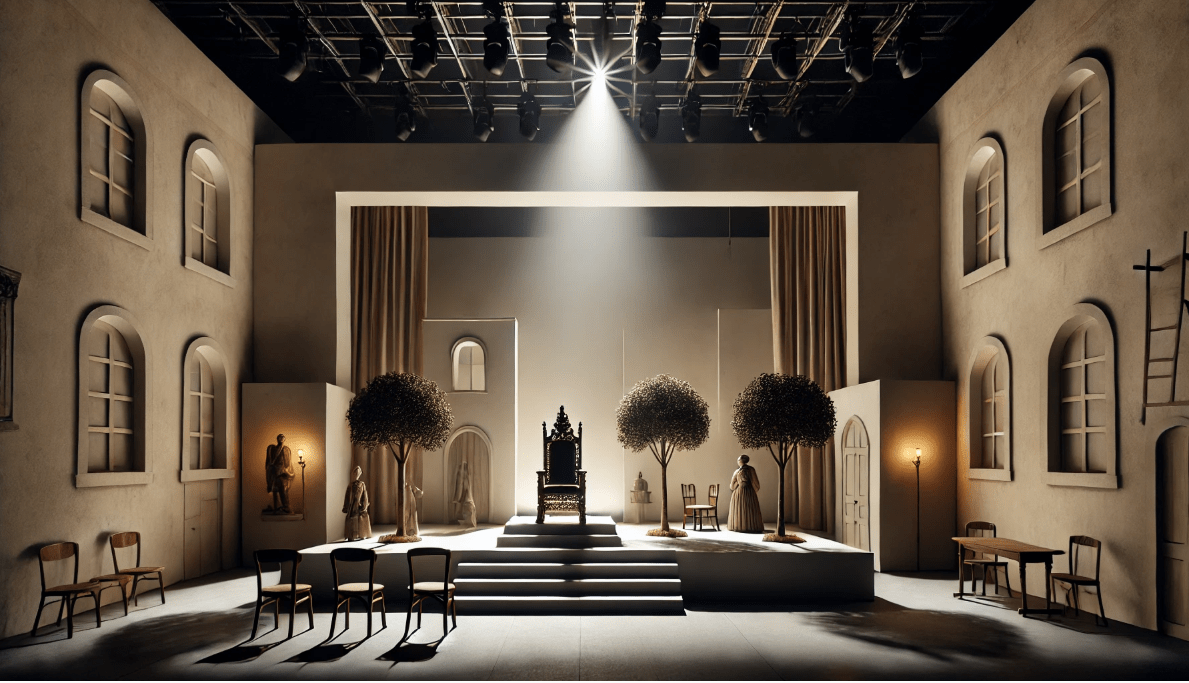
- Practical Insight: Modern designers can take a cue from Shakespeare’s minimalist approach. Sometimes less is more—simple, suggestive props can create powerful imagery without overwhelming the audience. This approach encourages imagination and makes the experience more engaging.
Creative Use of Props: Transforming the Stage
Shakespeare’s plays often required quick changes between settings. To address this, the Globe Theatre used versatile props to represent multiple locations, enabling fast transitions. A single piece of furniture or a few objects could take the audience from a castle to a forest, or a battlefield to a palace. This creative use of props minimized the need for elaborate scene changes, keeping the focus on the story and the actors. 🎭
- Actionable Insight: In modern stage design, flexibility is key. Using versatile props that can easily be reconfigured can help streamline scene changes and allow for a more fluid production. This approach saves time and maintains the flow of the story.
Lighting and Atmospheric Effects: Setting the Mood
While Shakespeare didn’t have modern lighting technologies, he understood the importance of creating atmosphere. At the Globe, natural daylight was used to enhance the mood of a scene. For evening or dramatic scenes, torches and candles were lit to create a darker, more mysterious environment. 🌙
- Practical Insight: Today’s lighting technology allows designers to create powerful atmospheres, from dramatic shadows to soft glows. Lighting can be used not only to illuminate the stage but to set the emotional tone of a scene. Whether you’re using colored gels, spotlights, or LED lights, think about how your lighting can enhance the mood of the performance.
Sound and Special Effects: Adding Drama and Realism
Shakespeare also used sound and other special effects to add drama to his plays. For example, sound effects like thunder or the clanging of swords helped create a sense of realism and excitement. While technology was rudimentary, the effect was still impactful in drawing the audience into the world of the play. ⚡
- Actionable Tip: Modern theatre designers can use sound effects and music to heighten the emotional intensity of a scene. Subtle sound cues or dramatic music can elevate tension and build anticipation. Think of how a well-timed sound effect can make a scene unforgettable.
Creating Transitions with Visuals: The Power of Simple Effects
Shakespeare’s minimalist sets didn’t mean a lack of creativity. Instead, the focus was on using visual transitions to help move the story forward. A simple change in lighting, a shift in props, or even the movement of actors could signal a change in time, location, or mood. This was an early form of what we now consider special effects—using visual cues to enhance storytelling.
- Practical Insight: To keep your audience engaged, use simple but effective visual cues to signify transitions. Whether it’s a change in lighting, a shift in scenery, or a transformation of a single prop, small changes can dramatically affect how the story unfolds.
Shakespeare’s creative approach to scenic design and special effects set the stage for modern theatre techniques that prioritize atmosphere, imagination, and minimalism. Today’s designers continue to draw inspiration from his work, using lighting, props, and sound to create rich, immersive experiences that captivate audiences. By embracing these timeless techniques, you can elevate any performance and bring Shakespeare’s legacy to life. 🌟
5. Lighting and Acoustic Advances: How Shakespeare Influenced Theatre Technology
Although Shakespeare didn’t have access to the advanced lighting and sound systems we use today, his innovative use of lighting and acoustics laid the groundwork for many of the techniques modern theatre designers use. Let’s take a look at how Shakespeare’s impact on lighting and acoustics still shapes the way we experience live performances today. 💡🎶
Natural Lighting: A Master of Atmosphere
At the Globe Theatre, performances were held during the day, making the most of natural daylight. This allowed for the mood of a scene to change depending on the time of day. For instance, a sunny afternoon could create a light, cheerful atmosphere, while a cloudy, overcast day could signal a darker, more intense scene.
- Practical Insight: Modern theatres may rely on artificial lighting, but the concept of lighting to set mood remains key. Think about how lighting can evoke different emotions in your audience, from the soft glow of warm colors for romance to harsh, sharp lights for suspense. 🌟
Candles and Torches: Early Special Effects
For evening performances, the Globe used candles and torches to light the space. This not only created an intimate atmosphere but also added dramatic flair. The flickering lights created shadows, enhancing the mood of suspense or danger in scenes, particularly in plays like Macbeth.
- Actionable Insight: Modern lighting techniques can take inspiration from Shakespeare’s use of dramatic lighting to enhance key moments. Whether you use spotlights, colored gels, or atmospheric lighting effects, think about how these tools can elevate pivotal scenes, just as Shakespeare did with his simple lighting methods. 🔦
Acoustics: Amplifying the Voice
The Globe Theatre’s open-air design meant that acoustics were critical. Shakespeare’s actors had to project their voices to be heard by thousands of people, so sound and acoustics were essential elements of the performance. The open space naturally enhanced the acoustics, allowing voices to carry across the large venue.
- Practical Tip: Today, acoustics are still a crucial consideration in theatre design. Modern venues often use sound engineering to ensure clarity of voice and music. Whether you’re designing a space or producing a show, consider the acoustics carefully. Optimizing sound systems and arranging the seating can ensure the audience gets the best experience. 🎤
The Evolution of Sound Design: From Echoes to Technology
Although Shakespeare didn’t have modern sound effects, his use of sound cues—like the ringing of a bell or the clash of swords—added realism and tension to his plays. These simple sound effects were crucial for creating atmosphere and helping the audience feel more connected to the action.
- Actionable Insight: Modern theatre designers continue to use sound effects to build atmosphere. Whether it’s thunder for a storm or music to set the mood, sound is a powerful tool. Today, sophisticated sound systems and microphones allow for even more complex effects, but the core principle remains the same: sound amplifies the emotional experience. ⚡
The Transition to Electric Lighting and Modern Sound
Shakespeare’s legacy in lighting and sound can still be seen today in modern electric lighting and sound systems. Many theatres now use LED lights, spotlights, and dynamic sound effects to create immersive environments. These advances in technology allow for more dramatic transitions between scenes and a stronger connection between the performance and the audience.
- Practical Insight: Whether you’re working in a small community theatre or a large professional venue, the principles of lighting and sound that Shakespeare pioneered are still vital. Using lighting to guide the audience’s attention or using sound to create tension and mood is as important now as it was in Shakespeare’s time.
Shakespeare may not have had electric lights or microphones, but his use of lighting and sound laid the foundation for modern theatre technologies. Today, these elements continue to help us tell stories more powerfully, from creating mood to amplifying voices. By understanding and applying the basics of lighting and acoustics, theatre designers can create more immersive and emotionally engaging experiences, just as Shakespeare did centuries ago. 🎭🌟
6. The Audience and Actor Relationship: Shakespeare’s Approach to Engagement
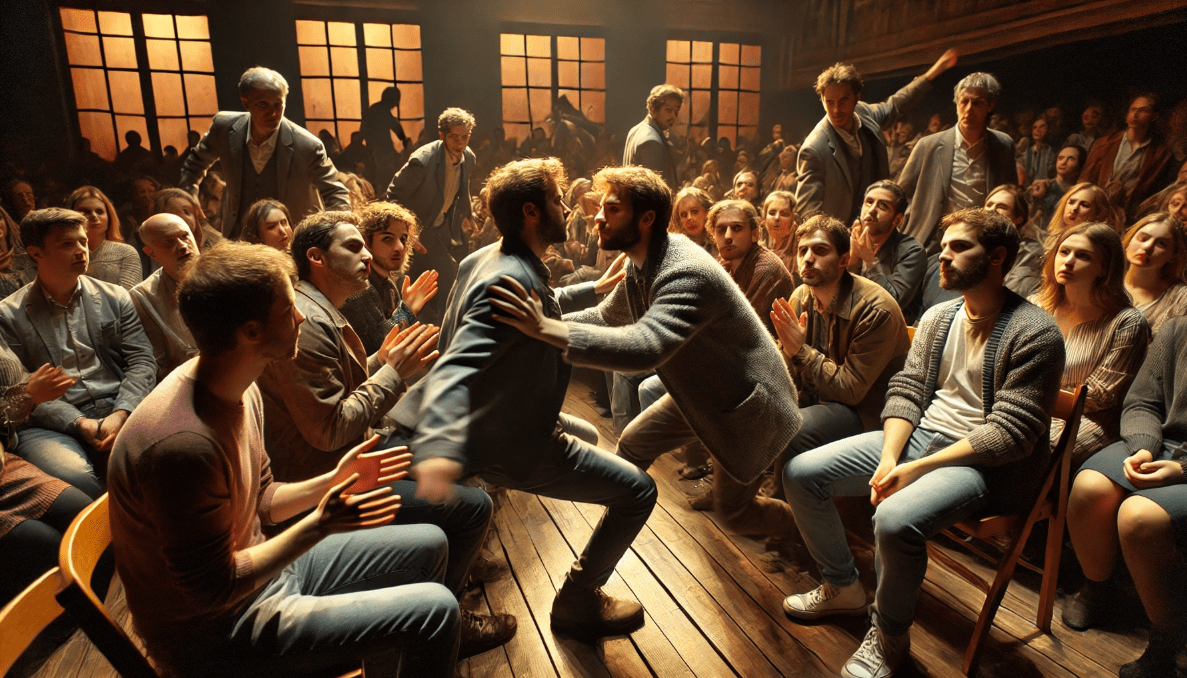
One of Shakespeare’s most innovative contributions to theatre wasn’t just in the design of the stage, but in how he engaged the audience. At the Globe Theatre, the line between actors and spectators was often blurred, creating an interactive and immersive experience that still influences modern theatre today. Let’s explore how Shakespeare fostered a unique relationship between the audience and the actors. 🎭
Breaking the Fourth Wall
Shakespeare’s theatre designs encouraged direct interaction between actors and the audience. Unlike modern proscenium stages, where the action takes place “behind a fourth wall,” the Globe Theatre’s thrust stage brought actors into the midst of the audience. This setup encouraged actors to address the audience directly, creating a sense of inclusion and intimacy. 🌟
- Practical Insight: Modern theatre designers often use thrust stages or arena-style seating to recreate this intimacy. If you’re working on a production, consider how the actors can move through or engage with the audience to make them feel like active participants in the story.
Proximity and Intimacy
The Globe Theatre’s open design allowed the audience to be close to the action. In the “pit,” standing audience members were just a few feet away from the actors, creating an intense, personal connection. The sense of proximity meant that every word, every gesture mattered—and the audience’s reactions could be felt immediately by the performers. 🥰
- Actionable Insight: If you’re designing a theatre or planning a performance, think about how audience proximity can enhance emotional engagement. A closer, more intimate seating arrangement can help foster a deeper connection, making the audience feel more involved in the experience.
Audience Participation and Reaction
At the Globe, audience members weren’t just passive observers—they were active participants in the performance. They could laugh, shout, cheer, or even boo. This engagement added energy to the performance, creating a lively atmosphere where the actors responded to the reactions of the audience.
- Practical Tip: Modern theatre designers use interactive elements like audience voting, immersion zones, or even live feedback to keep spectators engaged. Think about how you can invite the audience to participate in some way to enrich the experience.
Engagement Through Physical Movement
Shakespeare’s actors often moved around the stage in ways that encouraged engagement. The design of the Globe Theatre, with its multiple levels and thrust stage, gave actors the freedom to walk among the audience, creating a dynamic, fluid experience. This physical movement made the performance feel alive and immediate. 🏃♂️
- Actionable Insight: Encourage your actors to move throughout the space rather than stay confined to one spot. This helps keep the audience engaged, especially when using more interactive or immersive staging techniques.
Keeping the Audience’s Attention
Shakespeare understood that audiences need to be engaged at all times. He used clever dialogue, emotional arcs, and physical action to keep the audience’s attention. The direct interaction between the performers and the spectators helped to maintain focus, and the audience’s emotional investment was key to the success of the performance.
- Practical Tip: Keep your audience engaged by varying the pace of the performance. Use dynamic changes in energy—whether through fast-paced scenes, emotional dialogue, or exciting action—to hold their attention.
Shakespeare’s approach to the audience-actor relationship changed the way theatre was experienced. By eliminating the “fourth wall,” creating proximity, and encouraging audience participation, he laid the foundation for the interactive, immersive theatre experiences we enjoy today. Whether you’re designing a stage, producing a play, or just watching a performance, think about how you can engage your audience more deeply, just as Shakespeare did centuries ago. 🎉
7. Shakespeare’s Influence on Theatre Design in the Modern Age
Shakespeare’s influence on theatre design is not just a piece of history—it continues to shape the way we experience live performances today. From stage layout to audience engagement, many modern theatre designs draw inspiration from the innovations Shakespeare introduced at the Globe Theatre. Let’s explore how his legacy lives on in today’s theatre world. 🎭
Thrust Stages: Maintaining Audience Proximity
One of Shakespeare’s most influential contributions was the thrust stage, where the performance space extends into the audience. This layout, which places actors closer to the audience, remains a popular feature in modern theatres. By bringing performers closer to the audience, a more intimate and interactive experience is created, much like in Shakespeare’s day.
- Practical Insight: If you’re designing or attending a theatre with a thrust stage, you’ll notice a more personal connection between the actors and the audience. This design enhances emotional engagement and helps the audience feel like part of the performance. Consider this layout for productions that rely on strong emotional connections. 💡
Arena Seating: Breaking Boundaries
Shakespeare’s use of the Globe Theatre’s open design broke away from traditional, enclosed theatre spaces. Today, many theatres use arena-style seating where the audience surrounds the stage. This style of seating fosters a sense of immersion and inclusion, allowing the audience to view the performance from all angles—just as the Globe Theatre once did.
- Actionable Tip: If you’re looking to create a more immersive experience, consider theatre designs that incorporate arena seating. This arrangement makes the performance more dynamic, as the audience’s presence becomes an integral part of the experience. 🎟️
Flexible Stage Designs: Adapting to Modern Needs
The Globe Theatre’s flexible and minimalist design was key to Shakespeare’s ability to perform a variety of plays with quick scene changes. Modern theatres have embraced this flexibility, with modular stages and revolving sets that allow for easy transitions between different scenes and locations.
- Practical Insight: In today’s productions, versatility in stage design is essential. Whether you’re using a rotating stage or adaptable sets, this flexibility allows you to create multiple environments without needing complex scene changes. This approach saves time and keeps the performance flowing smoothly. 🔄
Audience Engagement: The “Fourth Wall” Remains Fluid
Shakespeare’s ability to blur the lines between actor and audience has influenced modern theatre’s move towards more immersive and participatory experiences. Today’s productions often encourage direct audience interaction, from actors engaging with the crowd to immersive theatre where the audience becomes part of the performance.
- Actionable Insight: Modern theatres that break the fourth wall create a richer, more engaging experience. Consider designing performances that involve audience participation, whether through direct interaction or by creating a shared environment where spectators are part of the action. 🤝
Simplified Scenic Design: Focus on Storytelling
Shakespeare’s minimalist approach to scenic design—using simple props and relying on the audience’s imagination—continues to influence how sets are designed today. Many contemporary productions choose simplified sets to emphasize storytelling rather than overwhelming the audience with elaborate backdrops.
- Practical Tip: If you’re a designer or director, consider embracing minimalist designs. Simple, versatile props can suggest a range of locations and themes, letting the audience’s imagination fill in the rest. This approach can make your performance feel more grounded and focused. 🛋️
Innovative Use of Technology
While Shakespeare didn’t have modern lighting and sound equipment, his innovative use of lighting (through natural sunlight) and sound (such as bells and thunder effects) laid the groundwork for today’s technological advancements. Modern theatres now use sophisticated lighting systems, sound effects, and projected visuals to enhance the storytelling experience.
- Actionable Insight: Whether you’re designing a new space or directing a show, using modern technology in creative ways—such as lighting to shift the mood or sound to signal transitions—can make a huge difference in the impact of your performance. 🌈
Shakespeare’s influence on theatre design is still felt today, with many modern theatres incorporating his innovations in stage layout, audience engagement, set design, and use of technology. By embracing these timeless principles, theatre makers continue to create more dynamic, immersive experiences that resonate deeply with audiences. Whether you’re designing a new theatre or simply appreciating a performance, Shakespeare’s legacy continues to shape the way we experience live theatre. 🌟
8. How Theatre Designers Can Apply Shakespeare’s Innovations Today
Shakespeare’s innovations in theatre design have stood the test of time, and modern theatre designers can still draw inspiration from his work to create dynamic, engaging performances. Whether you’re designing a new theatre, staging a play, or looking for ways to connect with today’s audience, here are practical tips for applying Shakespeare’s timeless innovations in the modern world. 🎭
1. Use Thrust Stages for Greater Audience Engagement
Shakespeare’s thrust stage design brought actors closer to the audience, creating a more intimate and interactive experience. This setup continues to be popular in modern theatre for its ability to break the fourth wall and engage the audience.
- Actionable Tip: Consider designing your stage with a thrust layout if you’re aiming to foster a stronger connection between the performers and the audience. It’s perfect for productions that rely on strong emotional engagement or intimate dialogue. 💡
2. Embrace Minimalist Set Designs
Shakespeare’s minimalist approach to scenic design—where props and simple backdrops were used to suggest various settings—allowed the audience’s imagination to take center stage. This simplicity also allowed for faster scene transitions and a more fluid performance.
- Practical Insight: If you’re designing a set, remember that less can be more. Using versatile props and minimal set pieces can help focus attention on the actors and storytelling, without distracting from the narrative. Think about how you can use imagination rather than intricate designs to convey multiple locations. 🛋️
3. Incorporate Arena Seating for Immersive Experiences
The Globe Theatre’s open design and flexible seating encouraged active audience participation. Today, arena seating (where the audience surrounds the stage) creates a similar immersive experience, allowing spectators to feel part of the action.
- Actionable Insight: If you’re designing a theatre space, consider using arena-style seating to foster a more immersive, participatory environment. This setup is especially effective for performances that benefit from close audience involvement. 🎟️
4. Focus on Lighting and Sound to Set the Mood
Shakespeare used natural lighting during the day to enhance the mood of a scene. Even though today’s theatres rely on advanced lighting technologies, the principle of using light and sound to influence the atmosphere remains key.
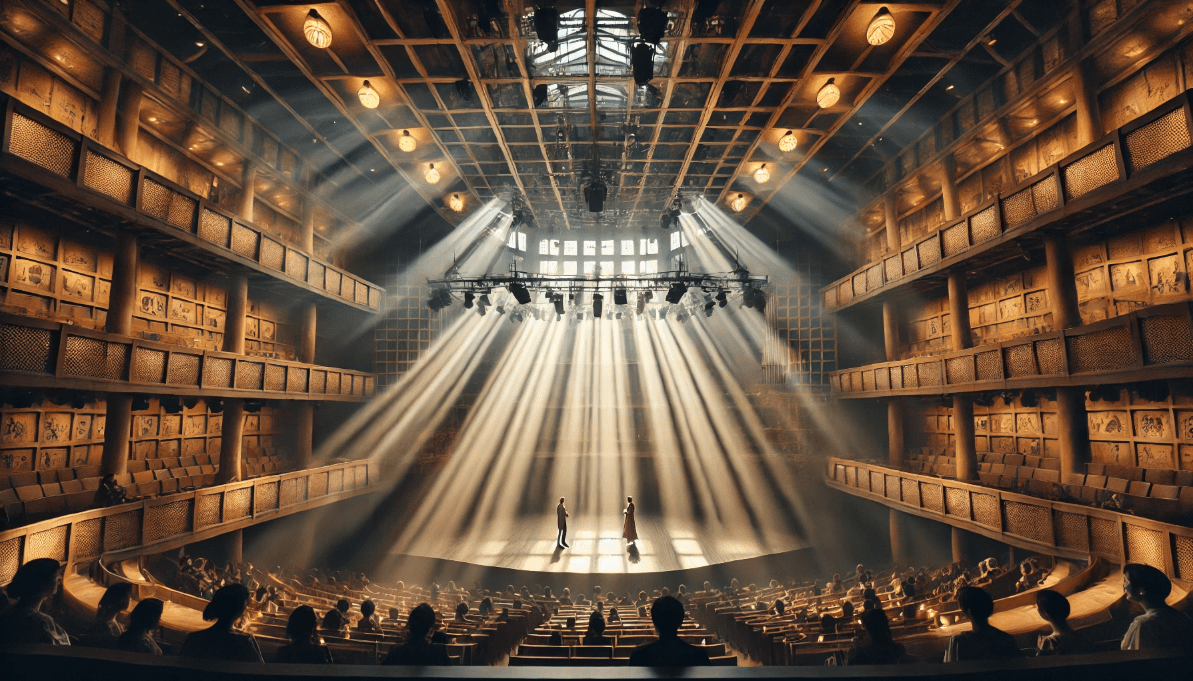
- Practical Tip: Use lighting to convey emotion, such as warm, soft lighting for romantic scenes or sharp, cold lighting for moments of tension. Similarly, sound effects and music should be used strategically to build suspense or highlight key moments. ⚡🎶
5. Make Scene Transitions Seamless with Flexible Design
At the Globe, Shakespeare’s minimalist sets and flexible staging made quick scene changes possible without losing momentum. Modern theatre designers can take this idea further with modular, rotating, or multi-level sets that allow for fluid transitions between different environments.
- Actionable Insight: In your stage design, consider using modular sets that can easily be reconfigured for different scenes. This flexibility not only speeds up transitions but also keeps the audience’s attention focused on the performance. 🔄
6. Create Opportunities for Direct Audience Engagement
Shakespeare’s actors often interacted directly with the audience, whether through breaking the fourth wall or engaging with spectators in the pit. This interaction kept the audience emotionally invested and made them feel part of the action.
- Practical Insight: Look for opportunities to break the fourth wall or involve the audience in your production. This could include direct dialogue with the audience, immersive experiences where spectators are part of the scene, or even inviting them to participate in the performance. 🤝
7. Use Technology to Enhance, Not Distract
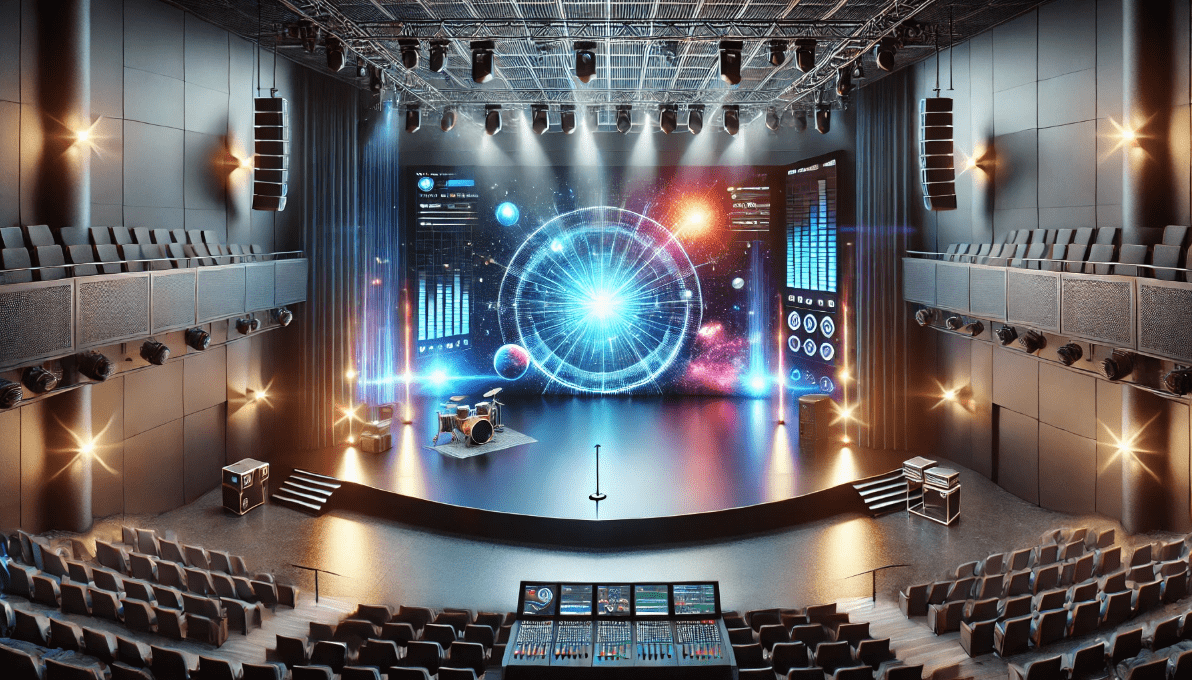
Shakespeare didn’t have the benefit of modern technology, but today’s designers can use lighting, sound, and projections to enhance the narrative. However, just like Shakespeare’s minimalism, technology should serve the story, not overpower it.
- Actionable Tip: Use projected visuals or sound effects sparingly to enhance key moments without distracting from the actors. The goal should always be to support the storytelling, just as Shakespeare did with his simple but effective lighting and sound techniques. 🌟
By embracing Shakespeare’s innovations in stage design, audience engagement, and scenic simplicity, modern theatre designers can create performances that are immersive, engaging, and emotionally resonant. Whether through thrust stages, minimalist sets, or innovative lighting and sound, these timeless principles help bridge the gap between past and present, allowing theatre to continue evolving while maintaining a deep connection with the audience. 🎭
Shakespeare’s influence on theatre design is more than just a historical curiosity—it’s a living legacy that continues to shape the way we experience theatre today. From the thrust stage that brought actors closer to the audience to his minimalist scenic designs that sparked the imagination, Shakespeare’s innovations transformed the theatre into a more interactive, engaging, and dynamic space. 🎭
By embracing his techniques, modern theatre designers can create performances that are not only visually stunning but emotionally impactful. Whether it’s through using arena seating for immersion, lighting to set the mood, or direct audience interaction to break the fourth wall, Shakespeare’s principles offer valuable insights for today’s theatre world. 🌟
Frequently Asked Questions (FAQs)
1. How did Shakespeare influence theatre stage design?
Shakespeare revolutionized theatre design with his thrust stage, where the performance area extended into the audience, creating a more immersive experience. His minimalistic set designs and use of natural lighting also helped shape modern theatre architecture, making it more interactive and dynamic. 🎭
2. What is a thrust stage, and why is it important?
A thrust stage is a stage that juts out into the audience, with seating on three sides. This design breaks the traditional “fourth wall” and fosters direct interaction between actors and the audience, creating a more intimate, engaging experience that continues to be used in modern theatres. 💡
3. How did Shakespeare’s Globe Theatre influence modern stage design?
Shakespeare’s Globe Theatre set the standard for flexible stage designs with its circular layout, multiple audience levels, and thrust stage. These innovations not only improved audience engagement but also influenced modern stage layouts and audience seating arrangements in theatres worldwide. 🌍
4. What is the significance of the "fourth wall" in theatre?
The fourth wall refers to the invisible barrier between the actors on stage and the audience. Shakespeare’s use of direct interaction with the audience, such as actors addressing spectators, helped break this barrier, creating a more immersive and dynamic theatre experience. 🎟️
5. How did Shakespeare use lighting and acoustics in his time?
Shakespeare used natural lighting during daytime performances to set the mood and relied on simple sound effects (like bells and music) to enhance atmosphere. While modern theatres use advanced lighting and sound technology, these early practices laid the foundation for their creative use in today’s theatre. 🌟
6. How did Shakespeare's minimalist set designs influence modern theatre?
Shakespeare’s minimalist set designs used versatile props to suggest various locations, allowing the audience to imagine different settings. This approach influenced modern designers to focus on flexibility and simplicity in sets, allowing the actors and the story to take center stage. 🛋️
7. How can modern theatre designers apply Shakespeare's principles today?
Modern designers can apply Shakespeare’s ideas by using thrust stages to bring actors closer to the audience, embracing minimalist sets, and creating interactive experiences that break the fourth wall. These principles make performances feel more immersive and emotionally impactful. 🎭.
8. Why is audience engagement important in modern theatre design?
Audience engagement is key to creating a deeper emotional connection. Shakespeare’s designs, which brought actors and audiences closer together, set the stage for today’s theatres that use arena-style seating, direct interaction, and immersive techniques to make the audience feel part of the story. 🤝
